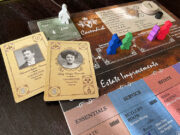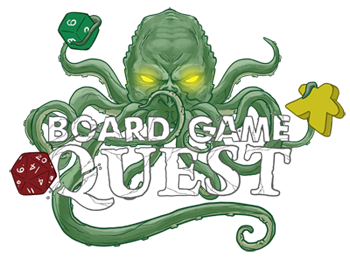 As a long-time Star Trek: Attack Wing player, I was cautiously optimistic when I heard that WizKids was doing another Star Trek miniatures game. I always enjoyed Attack Wing (it is one of my favorites!), but lightning doesn’t always strike twice of course. Or is that never strikes twice… I’m not good with clichés.
As a long-time Star Trek: Attack Wing player, I was cautiously optimistic when I heard that WizKids was doing another Star Trek miniatures game. I always enjoyed Attack Wing (it is one of my favorites!), but lightning doesn’t always strike twice of course. Or is that never strikes twice… I’m not good with clichés.
Star Trek: Into the Unknown is a game for 2 players out-of-the-box, and games can take a good chunk of time: possibly up to 2 or even 3 hours. Though it can be shorter, especially the single ship intro mission.
Gameplay Overview:
Each game is meant to represent an episode of the show, including a division into “acts.” The game begins with an overture, which sets the stage for the situation with mission objectives for both sides. At a certain point in the game, there is a second act which is a complication that alters the rules for the remainder of the game. This complication happens at different times depending on the scenario being played and typically varies depending on which side has an advantage at that point in the game. The rest of the game is played out under the new conditions, and whoever is more successful at completing their objectives (and thus, earning more Victory Points), wins.

In the core set, the two available sides are the Federation (fielding a Defiant-class, a Constellation-class, and a Galaxy-class) and the Dominion (fielding 2 Jem’Hadar fighters and a Jem’Hadar Battlecruiser). With limited options, most games will use all of your ships, though presumably expansions will allow a greater degree of customization. Each ship has a board with several dials indicating statuses such as crew health, available power, hull, and alert status, as well as a miniature and a number of crew and upgrades assigned to it.
Each round consists of 5 phases, which each player carries out before moving on to the next. The phase that generally takes up the most time is the first, the Priority Phase. Both players take turns performing actions available to their ships. Each ship’s actions are related to one of the stations (Command, Engineering, Helm, etc…) on its shipboard. To take an action during this phase, you “commit” an officer that is at that station (and possibly expend ship power, if required). This means that your actions are inherently limited by the number of officers you have available on your ship. The actions you can take are many, from firing weapons to performing impulse or warp maneuvers.
The following phases tend to proceed much more quickly once both players have completed all actions they are able (or want) to do during the Priority Phase. The Standby Phase is similar to the Priority Phase, but each ship is allowed one action, and an officer is not required. The Hazard Phase (aptly named) consists of essentially all the bad stuff happening! Hazards and damage happen in this phase. The Ready Phase largely consists of preparing for the next round. You can Ready up to 3 officers that preformed actions, move officers around your ship, and gain back ship power. The final phase, the Hail Phase, is fairly unique and very Star Trek, and involves “trust” tokens to represent diplomacy, and can be a way to gain Victory Points towards the mission.

Game Experience:
I’ve tried to provide a brief summary of the gameplay, and that doesn’t necessarily do it justice. There is quite a bit going on in this game. It isn’t the fairly basic format of Star Trek: Attack Wing or Away Missions. You have a lot of choices, and early on it can be a little overwhelming to find your footing.

Ultimately, a lot of it boils down to similar concepts, however. Most actions require you to do a skill test, and the officers that you commit to the actions have skills, which enhance your chances of success. As a result, in most rounds, you’ll be rolling the dice for skill checks a good bit. That does introduce a degree of chance, but that feels very Star Trek. Oftentimes our heroes get lucky breaks. And it is not all outside of the player’s control, as you can accrue advantage tokens (or be given peril tokens) to modify your test rolls.
There are several areas where the design really shines. Firstly, and I think most importantly, is that this feels very much like Star Trek. Each side has mission objectives to complete to gain their Victory Points, and those objectives are generally not “blow up the other team” (I’m sure this will change when there are Klingons introduced…).

In fact, the player who initiates hostilities can get a Victory Point penalty for doing so. You might have to take a calculated risk that combat is worth that sacrifice in the long run. Missions can erupt into conflict, but finding a way to win without it is often the right solution. It naturally feels like an episode as a result.
Secondly, the board is set up with divisions into one or more “systems” with the rest of the board essentially “at warp” interstellar space. While this can feel a bit constraining when you’re flying the Enterprise-D or the battlecruiser, it creates interesting space for the missions. You can go do a mission objective in one system without taking a quantum torpedo from an enemy ship light years away.
Lastly, the way you need to manage your crew and resources makes you think. Some of the ships are quite large, so they can do a lot, but resources and personnel aren’t infinite. Assigning those personnel where they’re going to be effective is important (if you need a hail to go well, you send Picard, not someone with a different expertise like O’Brien).

One area that I’ve not touched on much so far is the combat. It isn’t a huge part of the game, but it is there and it is relevant, much like the shows. It functions similarly to a lot of the rest of the game. Your attack is a test based on the skill of the officer you commit to the attack, and its success or failure is determined by your roll against the target’s evasion (it is hard to miss a battlecruiser!).
When taking damage, ship power is spent to absorb damage to the shields, unless that power is gone! Then you take hull damage on the appropriate dial and possibly unique damage cards—each ship has its own. What I liked most about the combat was unlike pretty much any other Star Trek game I have played, it treats the torpedoes as dangerous as they should be. They are a projectiles that can be set to detonate after a certain number of rounds. When they do detonate they cause significant damage to everything in their area of effect, friend or foe.

Most games are what the game calls “incident” missions, which are basically just one-off games. There is also a campaign mode, however, which ties together multiple missions in an ongoing narrative. As you proceed through the campaign, the successes and failures of both sides gain you benefits and the ability to purchase additional upgrades (and familiar, famous crew members). While each game can take a while and this means a full campaign takes even longer, this feels like the best way to play.
The play time is probably the biggest critique here. If you’re ok with the complexity, then it is probably the only thing to be concerned about. The game just takes a while. A part of that can be attributed to the setup time (the setup charts for the system rings can be a little finicky), but ultimately there’s just a lot to do, and that makes it take time. Not something to squeeze in on a limited timeframe, but something you devote an evening to.
Final Thoughts:
Star Trek: Into the Unknown has a big learning curve. There’s no way around that. If you aren’t in for a more complex experience, this is not the game for you. However, once you have learned it, it is a fun game to play and immerse yourself in the theme. The rules can be difficult to get through, but the first learning mission featuring the Defiant against a single Jem’Hadar fighter is a good start. Ultimately, the game doesn’t shine until you’ve got your full fleet on the table.
No commentary on Star Trek: Into the Unknown is complete without talking about the miniatures. The word “miniatures” is one that should be used fairly lightly in some cases. The Enterprise-D and the battlecruiser are fairly massive compared to the Defiant and the fighters. They all look great, too. As a non-painter, I appreciate the degree of detail here. While the less than ideal paint schemes on Attack Wing minis was something I was always willing to overlook for the gameplay, it would have been nice if they looked as good as these Into the Unknown minis.

The Enterprise-D even has a separating saucer section, which is pretty cool. They are all roughly to scale with one another. This could get a little out-of-hand if they stick to the same scale for the forthcoming Romulan Warbird, but I suspect that may adjust the scale a little bit. Especially given how tight the systems can feel with the two current large ships.
Small side note on the miniatures. I also had the opportunity to look at the first of the “ship packs”: a metallic paint scheme version of the Galaxy-class. While the metallic paint does look snazzy (albeit perhaps less screen-accurate), it does not add anything in terms of gameplay, with the box only including the repainted mini, shipboard, and damage cards. Unless you prefer the metallic paint, it probably isn’t worth picking up at the moment. If there are more fleet-building options once there are more sets than just the core, being able to field two Galaxy-class could be interesting.
Final Score: 4.5 Stars – A fun, albeit dense, game with excellent miniatures that successfully evokes its Star Trek theme.
 Hits:
Hits:
• The structure of an episode with a twist partway through is very on-point for the franchise.
• Miniatures are truly a highlight when they could have easily been a miss.
• The campaign mode is excellent.
• Lots of options give you a lot to think about to achieve your objectives. And combat is typically not option number one.
Misses:
• The rules are daunting, and there’s complexity. The rulebook does not do the best job of explaining.
• Setting up according to the charts can be a bit of a chore in every game.
• The movement tool can be awkward at times. Feels like it could have been improved a little bit.





















